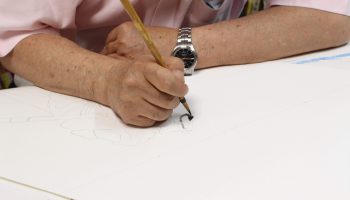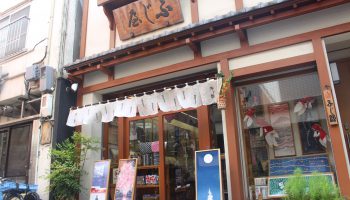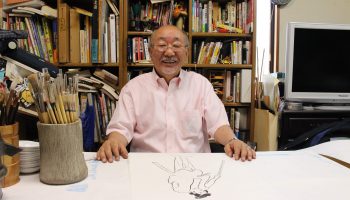Tenugui [ Hand Towels ]
Kawakami Chihiro

Mr. Chihiro Kawakami is a dyed picture tenugui hand towel craftsman who operates his shop, Fujiya, with his son.
Dyed picture tenugui hand towels are special towels that are created following a traditional method of using Washi (Japanese paper) moulds and glue to dye fabric known as Chusen Dyeing. The history of tenugui hand towels is very long. It is said that they were worn as personal adornments during Shinto rituals in the Heian Period (794-1185). They began to spread to the general population during the Kamakura Period (1185-1333) and eventually started to be used as aprons and hand towels during the Muromachi Period (1333-1573). When most people think of a tenugui hand towel they probably think of them as pieces of cloth used as hachimaki (headbands) and to absorb sweat, but in fact, the idea of enjoying them as decorations is quite old. There are even records detailing competitive tenugui hand towel shows held in meeting halls by cultured people, daimyo (feudal lords), and even townspeople during the Edo Period (1603-1868). In those days, it was an incredibly rare thing for people of different positions and social backgrounds to gather in the same place. At that time, people would have matching tenugui hand towels made with a group’s mark or symbol printed on it and all members of the group (ex. hobby group), festival group, and neighbourhood association would carry one.
Mr. Chihiro Kawakami became a dyed picture tenugui hand towel craftsman when he was 20, after he was influenced by his father, who was also in the same profession. He can still clearly remember when one of his drawings first became a tenugui hand towel.
Nowadays, the majority of tenugui hand towels being sold are print copies made by machines. However, at Fujiya, all tenugui hand towels are hand made in original designs. They use refined cloth to produce more colourful goods. The cloth is bleached several times to remove all impurities so the dyeing process comes out much clearer. Dyed picture tenugui hand towels are made following the same procedure as Ukiyoe woodblocks, where work is divided among specialists. At Fujiya, Mr. Chihiro Kawakami, and his son Masahiro draw an original sketch and take it to a mould making shop where the original drawing is carved into a mould. Moulds are based on the colours used, so one tenugui hand towel might require 2-3 different types of moulds. Once the moulds are prepared they are taken to the dyers. When the cloth is dyed it will shrink so it needs to be left for 7-10 days to allow the material to return to its original size. After that, the next mould can be used to add another colour, and the process is repeated. In order to complete a tenugui hand towel the cooperation of a reliable mould maker and dyer is necessary.
At Fujiya, they make and design many tenugui hand towels, but many customers also make requests for special orders. They take custom orders for weddings, store openings, anniversaries, award ceremonies, birthday celebrations, Buddhist memorial services, and a variety of other special occasions. Over the years they have also had the opportunity to set up stalls at events held overseas in the USA (Chicago and Detroit) and in Italy, where tenugui hand towels proved to be quite popular.
Mr. Chihiro Kawakami described an experience where a customer’s joy made him feel that his job was genuinely worthwhile. “Sometimes we hold special exhibitions at department stores and a customer will come in carrying a very old tenugui hand towel that we made and tell us they are still using it. When I hear a customer say they have been using one of our tenugui hand towels for such a long time I feel truly blessed.”
Dyed Picture Tenugui Hand Towels – Fujiya
Address: (Tokyo) Taito, Asakusa 2-2-15
Telephone: 03-3841-2283




